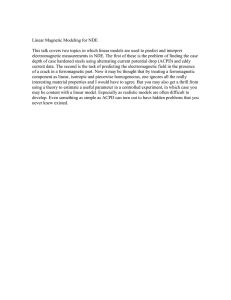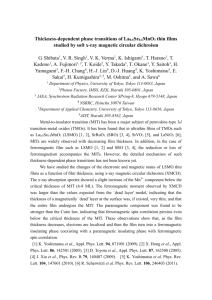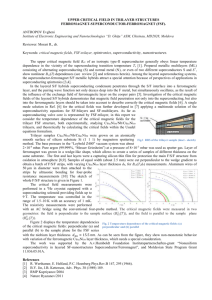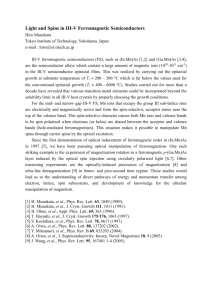Mean-field model of the ferromagnetic ordering in the
advertisement
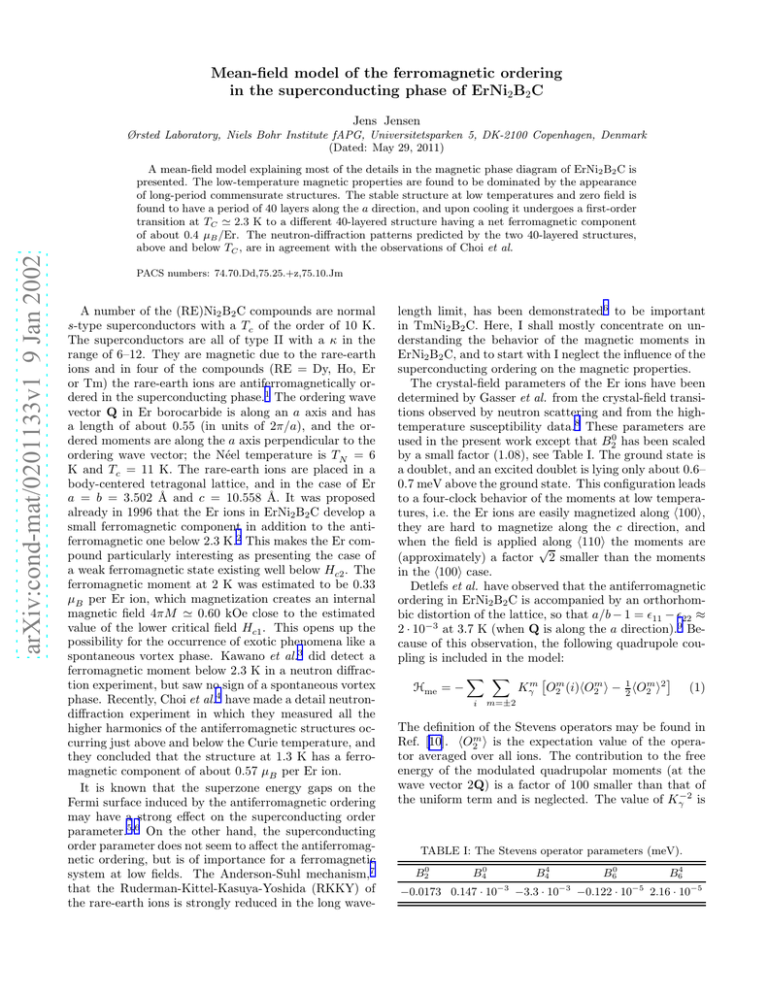
Mean-field model of the ferromagnetic ordering in the superconducting phase of ErNi2 B2 C Jens Jensen Ørsted Laboratory, Niels Bohr Institute fAPG, Universitetsparken 5, DK-2100 Copenhagen, Denmark (Dated: May 29, 2011) arXiv:cond-mat/0201133v1 9 Jan 2002 A mean-field model explaining most of the details in the magnetic phase diagram of ErNi2 B2 C is presented. The low-temperature magnetic properties are found to be dominated by the appearance of long-period commensurate structures. The stable structure at low temperatures and zero field is found to have a period of 40 layers along the a direction, and upon cooling it undergoes a first-order transition at TC ≃ 2.3 K to a different 40-layered structure having a net ferromagnetic component of about 0.4 µB /Er. The neutron-diffraction patterns predicted by the two 40-layered structures, above and below TC , are in agreement with the observations of Choi et al. PACS numbers: 74.70.Dd,75.25.+z,75.10.Jm A number of the (RE)Ni2 B2 C compounds are normal s-type superconductors with a Tc of the order of 10 K. The superconductors are all of type II with a κ in the range of 6–12. They are magnetic due to the rare-earth ions and in four of the compounds (RE = Dy, Ho, Er or Tm) the rare-earth ions are antiferromagnetically ordered in the superconducting phase.1 The ordering wave vector Q in Er borocarbide is along an a axis and has a length of about 0.55 (in units of 2π/a), and the ordered moments are along the a axis perpendicular to the ordering wave vector; the Néel temperature is TN = 6 K and Tc = 11 K. The rare-earth ions are placed in a body-centered tetragonal lattice, and in the case of Er a = b = 3.502 Å and c = 10.558 Å. It was proposed already in 1996 that the Er ions in ErNi2 B2 C develop a small ferromagnetic component in addition to the antiferromagnetic one below 2.3 K.2 This makes the Er compound particularly interesting as presenting the case of a weak ferromagnetic state existing well below Hc2 . The ferromagnetic moment at 2 K was estimated to be 0.33 µB per Er ion, which magnetization creates an internal magnetic field 4πM ≃ 0.60 kOe close to the estimated value of the lower critical field Hc1 . This opens up the possibility for the occurrence of exotic phenomena like a spontaneous vortex phase. Kawano et al.3 did detect a ferromagnetic moment below 2.3 K in a neutron diffraction experiment, but saw no sign of a spontaneous vortex phase. Recently, Choi et al.4 have made a detail neutrondiffraction experiment in which they measured all the higher harmonics of the antiferromagnetic structures occurring just above and below the Curie temperature, and they concluded that the structure at 1.3 K has a ferromagnetic component of about 0.57 µB per Er ion. It is known that the superzone energy gaps on the Fermi surface induced by the antiferromagnetic ordering may have a strong effect on the superconducting order parameter.5,6 On the other hand, the superconducting order parameter does not seem to affect the antiferromagnetic ordering, but is of importance for a ferromagnetic system at low fields. The Anderson-Suhl mechanism,7 that the Ruderman-Kittel-Kasuya-Yoshida (RKKY) of the rare-earth ions is strongly reduced in the long wave- length limit, has been demonstrated6 to be important in TmNi2 B2 C. Here, I shall mostly concentrate on understanding the behavior of the magnetic moments in ErNi2 B2 C, and to start with I neglect the influence of the superconducting ordering on the magnetic properties. The crystal-field parameters of the Er ions have been determined by Gasser et al. from the crystal-field transitions observed by neutron scattering and from the hightemperature susceptibility data.8 These parameters are used in the present work except that B20 has been scaled by a small factor (1.08), see Table I. The ground state is a doublet, and an excited doublet is lying only about 0.6– 0.7 meV above the ground state. This configuration leads to a four-clock behavior of the moments at low temperatures, i.e. the Er ions are easily magnetized along h100i, they are hard to magnetize along the c direction, and when the field is applied √ along h110i the moments are (approximately) a factor 2 smaller than the moments in the h100i case. Detlefs et al. have observed that the antiferromagnetic ordering in ErNi2 B2 C is accompanied by an orthorhombic distortion of the lattice, so that a/b − 1 = ǫ11 − ǫ22 ≈ 2 · 10−3 at 3.7 K (when Q is along the a direction).9 Because of this observation, the following quadrupole coupling is included in the model: X X Hme = − Kγm O2m (i)hO2m i − 21 hO2m i2 (1) i m=±2 The definition of the Stevens operators may be found in Ref. [10]. hO2m i is the expectation value of the operator averaged over all ions. The contribution to the free energy of the modulated quadrupolar moments (at the wave vector 2Q) is a factor of 100 smaller than that of the uniform term and is neglected. The value of Kγ−2 is TABLE I: The Stevens operator parameters (meV). B20 B40 B44 B60 B64 −0.0173 0.147 · 10−3 −3.3 · 10−3 −0.122 · 10−5 2.16 · 10−5 2 i,j i,j (2) where the classical coupling is determined by JD = N (gµB )2 = 1.194 µeV and the sum over the lattice of Dαβ (ij) = 3(riα − rjα )(riβ − rjβ ) − |ri − rj |2 δαβ N |ri − rj |5 (3) The two-ion Hamiltonian is accounted for in the meanfield approximation, Ji ·Jj ≃ Ji ·hJj i+hJi i·Jj −hJi i·hJj i. All the ordered structures are described by a wave vector Q along the a-axis and consist of ferromagnetic sheets perpendicular to Q. This means, firstly, that the different positions of the ions in the two sublattices have no direct consequences, corresponding to the use of a double-zone representation along h100i, and, secondly, that only the total couplings between the different ferromagnetic layers are important in the model. The interplanar coupling parameters are h i X J(0j) + JD Dk,⊥ (0j) (4) Jk,⊥ (n) = rj ·a=na2 /2 and the corresponding Fourier transforms Jk,⊥ (q). The parameter J⊥ (q) denotes the coupling between the components of the moments which are lying in the a–b plane perpendicular to q. The case of J⊥ (n) involves the following coupling parameters, J⊥ (n) = J⊥ (LD) cos(0.558 nπ) ; n = 10, 11, · · · , 16 all defined in terms of J⊥ (LD). Notice, that the coupling parameter for n = 9 is included separately. The final values of the interplanar coupling parameters are shown in Table II, where J⊥ (n) have been derived from the fitting of the experimental results discussed below, and Jk (n)−J⊥ (n) have been calculated using Eq. (3). The results for J⊥ (q) and Jk (q) are shown in Fig. 1. The most important parameters are the wave vector at which J⊥ (q) has its maximum, q = Q0 = 0.558 a⋆ , the maximum value itself J⊥ (Q0 ) and J⊥ (0) = Jk (0) = −12 µeV. The value of the parameter J⊥ (Q0 ) is assumed fixed at 21.56 µeV, which leads to a mean-field value of the Néel 20 Two−ion interaction (µeV) undetermined, but is only of minute importance for the model and is assumed to be equal Kγ2 . The calculated value of hO22 i is 34.6 at 3.7 K. Assuming (c11 − c12 )/2 to be about 5 · 1011 ergs/cm3 (consistent with a Debye temperature of the order of 400 K) then the distortion observed by Detlefs et al. indicates a value of Kγ2 = (V /2N )(c11 − c12 )[(ǫ11 − ǫ22 )/hO22 i]2 ≈ 0.7 · 10−4 meV. This value is close to the one used in the final fit: Kγ2 = Kγ−2 = 0.8 · 10−4 meV. The two-ion interaction is assumed to be the sum of a Heisenberg interaction and the classical dipole–dipole interaction: X X J(ij)Ji · Jj − 21 JD Dαβ (ij)Jiα Jjβ HJJ = − 12 J ll [010] 10 0 −10 J ll [100] −20 −30 0.0 0.2 0.4 0.6 (h,0,0) 0.8 1.0 FIG. 1: The perpendicular and parallel components of the two-ion interaction in ErNi2 B2 C along [100]. temperature TN = 6.0 K. The classical interaction gives rise to a large difference Jk (q) − J⊥ (q) of the same order of magnitude as the Heisenberg term itself. Due to the singular behavior of the dipole sum this difference is cancelled at zero wave vector, i.e. Jk (q) makes a jump by 4πJD = 15.0 µeV in the limit of q → 0. The neutron-diffraction experiment of Choi et al.4 revealed a large third harmonic below TN /2 showing that the modulation of the ordered moments approaches a square wave. The system shows a number of features indicating that commensurable effects are of decisive importance. The commensurable structures appearing may be rather complex limiting the possibility of deciphering the neutron-diffraction experiments. It has previously turned out to be of great value to assist the analysis of diffraction experiments by theoretical model calculations of the stability of the structures which may occur. This has been the case in the study of the long-period commensurable structures in the elemental erbium and holmium metals.10,11,12 The method used here is the same as in the previous works just cited, i.e. the free energies of different commensurable structures are calculated within the mean-field approximation by a straightforward iteration procedure, and the results are compared to each other in order to identify the most stable structure. The mean-field model presented above accounts for a great part of the observed properties of ErNi2 B2 C. Figure 2 shows the magnetization curves calculated at 2 K in comparison with the experimental results. All the calculated results are based on commensurable structures derived from the basic structure at Q = 21 (in units of a⋆ ). At low temperatures all the moments have a magnitude of about 7.9 µB and in one ferromagnetic layer they are either pointing parallel (u) or antiparallel (d) to the b axis (assuming Q k a). In the Q = 21 structure the ferromagnetic layers perpendicular to the a axis are polarized subsequently uudduudd. . . along the a direction. Structures 3 TABLE II: The planar two-ion coupling parameters (µeV). n J⊥ (n) Jk (n) − J⊥ (n) 0 5.847 −14.286 1 −3.816 −3.024 2 −4.786 3.106 3 −0.650 −0.630 10 Magnetic moment (µB/Er) T = 2.0 K H ll [100] 8 H ll [110] 6 4 2 0 H ll [001] 0 10 20 30 40 Applied Magnetic Field (kOe) 50 FIG. 2: The magnetization curves of ErNi2 B2 C at 2 K. The open circles are the experimental results of Cho et al.13 . The crosses connected by dashed lines show the experimental results of Canfield et al.2 . The remaining solid and dashed lines are the calculated results. The experimental and theoretical results in the case of H k [100] have been shifted upwards by 2 units. with larger values of Q are derived from this structure by a periodic replacement of one or more of the uu (dd) double layers with a single u (d) layer, the so-called spinslip structures.14 Important structures in the present case 6 structure consisting of the eleven layare the Q = 11 ered period d(uudd)2 uu = d(5p), the eighteen layered Q = 59 structure with the period d(uudd)2 u(dduu)2 = d(4p)u(4p), and the seven layered Q = 74 structure with the period duudduu = d(3p). Experimentally, the length of the ordering wave vector lies in the interval between 0.554 and 0.548,4 which range is covered by appropriate combinations of the three genetic structures. If the moments are of constant length, the d(5p) and the d(3p) structures have a net ferromagnetic component equal to 1 1 11 µmax and 7 µmax , respectively, whereas the structure d(4p)u(4p) has no uniform component. If the fundamental harmonic is the only one present the free energy has its minimum value at the wave vector at which the two-ion coupling has its maximum, i.e. at Q0 = 0.558 in the mean-field model defined above. However, the intensities of the higher-order odd harmonics increase rapidly as the temperature is lowered, which produce a shift of the ordering wave vector to a smaller value. In the model Q = 0.558 at TN , and it decreases 4 1.500 0.250 5 −1.500 −0.084 6 — 0.030 9 0.29 — LD 0.29 — rapidly between 5 and 3 K to become about 0.55 below 3 K. This behavior is consistent with the experimental observation4 of a change of the ordering wave vector between 5 and 3 K from 0.554 to 0.548. In the neutrondiffraction experiment of Choi et al.4 the peak due to the fundamental harmonic is found to be centered at Q = 0.548 at 2.4 K, however the higher harmonics indicate that the main part of the crystal is actually ordered in a commensurable structure with Q = 11 20 = 0.55. At 2.4 K, the stable structure with this wave vector is the 40-layered structure d(4p)u(5p)u(4p)d(5p). This structure, like the d(4p)u(4p) structure above, has no ferromagnetic component. However, due to the increasing importance of the higher harmonics as the temperature is lowered these structures are found to become unstable. The present mean-field model predicts the occurrence of a first-order transition between the structures d(4p)u(5p)u(4p)d(5p) → d(3p)d(5p)d(5p)d(5p) (5) at 2.24 K. Numbering the layers from left to right by 1 to 40, then the transition is accomplished by a reversal of the moments in the layers 9 and 20. The length of the moments changes slightly from one layer to the next, and the ferromagnetic moment is calculated to be 0.33 µB /Er just below the transition, and to be 0.40, 0.56 and 0.62 µB /Er at 2, 1.3 and 0 K, respectively, in agreement with the experimental values2,4 of 0.33 µB /Er at 2 K and 0.57 µB /Er at 1.3 K. The diffraction patterns of the different structures have been calculated and are compared with the results of the neutron-diffraction experiment of Choi et al.4 in Fig. 3. At 1.3 K the d(3p)d(5p)d(5p)d(5p) configuration gives rise to both odd and even harmonics (the even ones are marked by arrows) twice as many as produced by the d(4p)u(5p)u(4p)d(5p) structure at 2.4 K. The only discrepancy of some importance is the large value calculated for the intensity at h = 0.7 at 1.3 K. The splitting of the peaks around h = 0.45 and h = 0.65 at 1.3 K may be explained if a minor part of the crystal is ordered in 28 the Q = 51 structure, d(3p)d(5p)d(5p)d(5p)d(5p). Notice, that even this small change of the fundamental Q (from 0.55 to 0.549) leads to easily observable modifications in the positions of the higher harmonics. Hence, the overall agreement between the observed and calculated positions of the higher harmonics indicate with a high degree of credibility that the main part of the crystal 11 is a Q = 20 structure at 1.3 and 2.4 K. There exist other 11 choices for the low-temperature structure with Q = 20 than the one proposed in (5), but this structure, which is calculated to be the most stable one, is the only one producing a diffraction pattern that is reasonably similar to the one observed at 1.3 K. 4 6 tween Q = 11 and 59 are so close in free energy below 3 K that the model needs to be modified in order to differentiate clearly between the different Q values in this interval. This indicates that the peak in J(q) is possibly even more pronounced than assumed in the present calculations. A strong peak in the RKKY-interaction may be produced by the nesting between different areas on the Fermi surface discussed by Dugdale et al.,16 a nesting which is probably also responsible for the superconducting properties of these compounds. FIG. 3: Scan along [h, 0, 0] at T = 1.3 K, 2.4 K, and 4.38 K, measured with unpolarized neutrons. The data have been offset for clarity. The figure is a copy of Fig. 1 from Ref. [4] in which the calculated diffraction patterns in the different cases (the heavy solid lines) have been incorporated. The model calculations indicate that J(q) has a sharp peak at q = Q0 , as constructed in terms of the parameter J(LD). If this parameter is neglected the calculated variation of Q with temperature, or as a function of field, increases drastically. The dependence of Q on an applied field is going to be discussed in a forthcoming paper by Toft et al.15 In the present model all the structures be- 1 2 3 4 5 6 7 8 9 J. W. Lynn, S. Skanthakumar, Q. Huang, S. K. Sinha, Z. Hossain, L. C. Gupta, R. Nagarajan, C. Godart , Phys. Rev. B 55, 6584 (1997). P. C. Canfield, S. L. Bud’ko, and B. K. Cho, Physica C 262 249 (1996). H. Kawano, H. Takeya, H. Yoshizawa, and K. Kadowaki, J. Phys. Chem. Solids 60, 1053 (1999). S.-M. Choi, J. W. Lynn, D. Lopez, P. L. Gammel, P. C. Canfield, and S. L. Bud’ko, Phys. Rev. Lett. 87, 107001-1 (2001). A. Amici, P. Thalmeier, and P. Fulde, Phys. Rev. Lett. 84, 1800 (2000). K. Nørgaard, M. R. Eskildsen, N. H. Andersen, J. Jensen, P. Hedegård, S. N. Klausen, and P. C. Canfield, Phys. Rev. Lett. 84, 4982 (2000). P. W. Anderson and H. Suhl, Phys. Rev. 116, 898 (1959). U. Gasser, P. Allenspach, F. Fauth, W. Henggeler, J. Mesot, A. Furrer, S. Rosenkranz, P. Vorderwisch, and M. Buchgeister, Z. Phys. B 101, 345 (1996). C. Detlefs, A. H. M. Z. Islam, T. Gu, A. I. Goldman, C. It is important to realize that the ferromagnetic transition in ErNi2 B2 C is not due to a ferromagnetic interaction, which one is actually strongly negative. The ferromagnetic component is a byproduct of the lowtemperature commensurable structure. Even a large change of J(0) only have a slight influence on the transition, as the exchange-energy gain of this phase relatively to the pure antiferromagnetic phase is determined by the combined contribution of all the even harmonics. This means that the influence of the superconducting electrons on this transition, as for instance through the Anderson– Suhl mechanism,6,7 is weak. When the applied field in Fig. 2 is smaller than 1–2 kOe the response of the system is diamagnetic. The width of the fundamental harmonic in Fig. 3 indicates a correlation length along [1,0,0] which is at least 80 a, about twice the superconducting coherence length ξ. The absence of a spontaneous vortex phase, i.e. the diamagnetic response of the system at low fields, therefore suggests that the magnetic correlation length perpendicular to Q in the Meissner phase is much shorter than the parallel component. The model is going to be examined more closely in a paper presenting a neutron-diffraction determination of the magnetic structures in an applied field.15 Valuable discussions with P. Hedegård, K. Nørgaard Toft, and N. H. Andersen are gratefully acknowledged. 10 11 12 13 14 15 16 Stassis, P. C. Canfield, J. P. Hill, and T. Vogt, Phys. Rev. B 56, 7843 (1997); C. Detlefs, D. L. Abernathy, G. Grübel, and P. C. Canfield, Europhys. Lett. 47, 352 (1999). J. Jensen and A. R. Mackintosh, Rare Earth Magnetism: Structures and Excitations (Clarendon Press, Oxford, 1991). R. A. Cowley and J. Jensen, J. Phys. Condens. Matter 4, 9673 (1992). J. Jensen, Phys. Rev. B 54, 4021 (1996). B. K. Cho, P. C. Canfield, L. L. Miller, D. C. Johnston, W. P. Beyermann, and A. Yatskar, Phys. Rev. B 52, 3684 (1995). D. Gibbs, D. E. Moncton, K. L. D’Amico, J. Bohr, and B. H. Grier, Phys. Rev. Lett. 55, 234 (1985). K. Nørgaard Toft et al. (to be published). S. B. Dugdale, M. A. Alam, I. Wilkinson, R. J. Hughes, I. R. Fisher, P. C. Canfield, T. Jarlborg, and G. Santi, Phys. Rev. Lett. 83, 4824 (1999).
